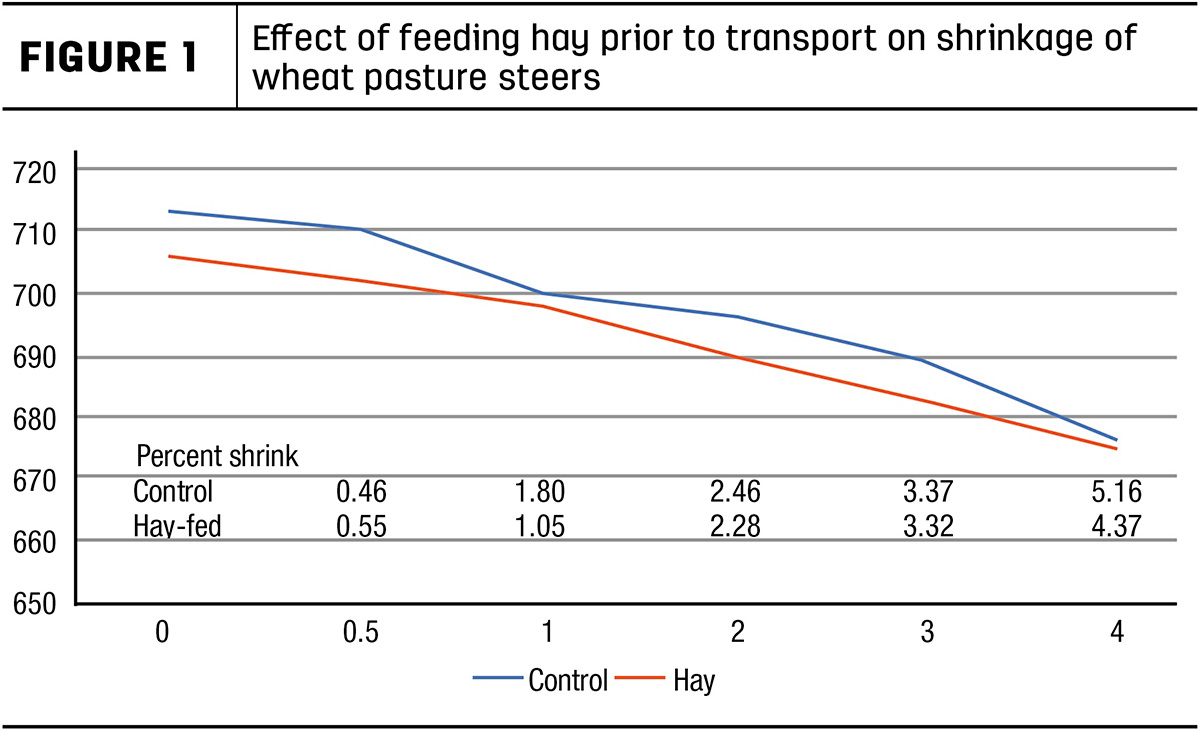All along the marketing chain of beef cattle, shrinkage of beef calves is a concern. Both sellers and buyers are constantly seeking information on shrink and weighing conditions of calves, feeder cattle and fats. When selling calves, shrink is a concern because it is a reduction in the sale weight, but abnormal levels of shrink are often used as a health indicator for cattle arriving in receiving facilities at stocker operations, grow yards and feedlots. Excessive shrink of finished cattle increases dark cutters at slaughter and depresses dressing percentage.
Lower levels of shrink are associated with losses of fill (feed and water) from the gastrointestinal tract; higher levels of shrink are indicators of tissue losses of body water, protein from muscles and fat. Adjustments in price are common to compensate for varying shrinkage and gut fill. The loss of weight from overnight shrinkage varies with the type of diet being fed to cattle. Hay- or dry-grass-based diets with slower digestion and passage rates will have lower shrinkage rates, while diets with higher water content (wheat pasture, spring grass or silage) or that are higher in digestibility (high-quality forages or high-concentrate diets) have faster passage rates from the gut and therefore higher shrink.
Shrink is often characterized into two categories: fill shrink and tissue shrink. Fill shrink is the loss of manure and urine from the digestive system. Fill shrink occurs when feed and water are withheld over time and can be up to a 6% loss in weight. This type of shrink is common in marketing and can be recovered quickly in a few days once cattle are back on feed and water. Tissue shrink is more severe, with shrinkage levels greater than 6% being associated with long periods without feed and water along with other stressors, such as long-distance transport, rough handling or heat stress. Tissue shrink may take up to 30 days to recover.
Generally, the amount of shrink varies with the type of feed cattle are on before penning and transport. Cattle consuming high-moisture diets, such as wheat pasture or other high-quality pastures, tend to shrink more when removed from feed than cattle fed drier diets. Wheat pasture is often 25% or less in dry matter – or over 75% water. It is one of the highest-moisture diets commonly used in cattle production, making it notorious for a high rate of shrink when cattle are removed from pasture and transported to markets or feedlots. Along with diet, there are many other management factors that influence loss of bodyweight and the rate of shrinkage. These include length of time off feed and water, weather conditions and weigh-up conditions (such as handling, how far it is from the pasture to the pens and cattle disposition).
Selling calves directly after weaning leads to some of the highest levels of shrink. Weaning is stressful, and calves are often unfamiliar with water and feed locations, so they may refuse to eat or drink even when feed and water are offered. Preconditioning programs have been designed to reduce the effect of weaning stress on calves later in production by enhancing the immune system and teaching calves to eat from a feedbunk and drink from a water tank or fountain at the ranch of origin. Preconditioning calves before marketing reduces shrink because the stress of separation from the dam has already occurred and calves are familiarized with handling and feed and water sources. Unweaned calves transported directly to the auction market can have shrinkage of 7% to 10% or more, while preconditioned calves can have 2% to 5% shrinkage.
Research was conducted in the early 1990s to look at shrink of calves coming off grass and possible interventions to reduce marketing shrink. Calves on wheat at Oklahoma State University were removed from pasture and weighed, then either penned in facilities next to the pasture or driven by foot up and down an adjacent dirt road for a total of 1.6 miles. Calves were then commingled and held in the drylot pens for 24 hours. Following the 24-hour shrink, cattle were reweighed and returned to pasture for 24 hours to determine the extent of weight recovery. When cattle were reweighed following 24 hours, they shrunk over 8%. Driving cattle on foot for 1.6 miles did not increase the amount of shrink compared with simply removing them from pasture and holding them for 24 hours without feed or water. The rate of shrink is quite high, related to the very high moisture content of the wheat forage, but cattle had regained all the lost weight by six hours after being placed back on pasture.
Two weeks later, this same group of steers was transported on trailers for four hours either directly off wheat pasture or after they were given access to hay and water for 24 hours. Initial shrink after 30-minute hauls were similar, only around 0.5% of initial weight. Weight loss of steers moved directly from pasture were much greater than steers fed hay before transport when hauls were one to two hours. After four hours of transit, steers directly off wheat lost 37 pounds (5.1% shrink). Steers given access to hay before transport lost 28 pounds (3.85% shrink) over the same haul. This shows that shrink losses were about 1.18% per hour of transport, but providing access to a dry hay before transport decreased shrink, possibly due to slower passage rate of feed through the digestive tract and less water loss (Figure 1).

Cattle market surveys have shown calves that are gaunt or shrunk prior to marketing have a $2-to-$4-per-hundredweight (cwt) premium over cattle with average fill. These premiums are unlikely to cover the lost revenue from the excessive weight loss due to shrink. Calves that were classified as “full” or “tanked” were discounted $4.73 and $11.10 per cwt, respectively, in a survey of Arkansas feeder cattle markets. These large discounts are reflective of buyer belief that excessive shrink will occur before cattle reach their final destination. There is value to both the buyer and seller for calves to have a fair weigh-up at marketing.







